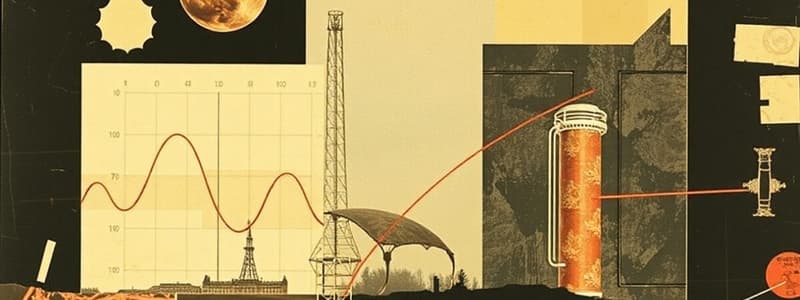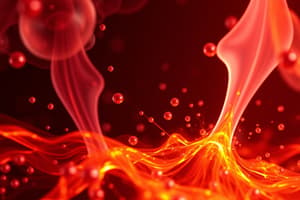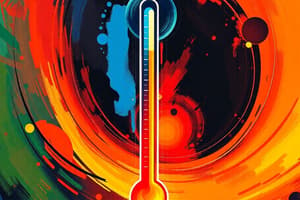Podcast
Questions and Answers
What is the primary focus of thermodynamics?
What is the primary focus of thermodynamics?
- The physical characteristics of matter
- The chemical composition of substances
- The interaction of a body with its surroundings involving energy transfer (correct)
- The properties of different chemical bonds
Which type of system can exchange energy and matter?
Which type of system can exchange energy and matter?
- Isolated System
- Equilibrium System
- Open System (correct)
- Closed System
Which of the following properties depend on the size of the system?
Which of the following properties depend on the size of the system?
- Heat Capacity (C) (correct)
- Pressure (P)
- Temperature (T)
- Color
What occurs during bond breaking?
What occurs during bond breaking?
In terms of sign convention, when is heat (q) considered positive?
In terms of sign convention, when is heat (q) considered positive?
What is the relationship between change in enthalpy and change in internal energy for a constant process?
What is the relationship between change in enthalpy and change in internal energy for a constant process?
In a free expansion of a gas, what is the change in entropy of the system?
In a free expansion of a gas, what is the change in entropy of the system?
What is the molar heat capacity at constant pressure for an ideal gas?
What is the molar heat capacity at constant pressure for an ideal gas?
According to the second law of thermodynamics, what is the entropy change in an isolated system?
According to the second law of thermodynamics, what is the entropy change in an isolated system?
Which of the following statements about entropy is true?
Which of the following statements about entropy is true?
What best describes internal energy (U)?
What best describes internal energy (U)?
In a reversible process, which of the following is true?
In a reversible process, which of the following is true?
Which process type represents constant temperature?
Which process type represents constant temperature?
According to the first law of thermodynamics, what is the correct equation for the change in internal energy?
According to the first law of thermodynamics, what is the correct equation for the change in internal energy?
What does the Zeroth Law of Thermodynamics state?
What does the Zeroth Law of Thermodynamics state?
What is the formula for the change in entropy for an ideal gas?
What is the formula for the change in entropy for an ideal gas?
Which statement characterizes a spontaneous process?
Which statement characterizes a spontaneous process?
What is the entropy change during the fusion process described by the equation?
What is the entropy change during the fusion process described by the equation?
At equilibrium conditions, which statement is true?
At equilibrium conditions, which statement is true?
How is the change in Gibbs Free Energy related to the electrical energy generated in a cell?
How is the change in Gibbs Free Energy related to the electrical energy generated in a cell?
What is the relationship expressed by the universal ratio between specific heat capacities?
What is the relationship expressed by the universal ratio between specific heat capacities?
In an isothermal process, what remains constant throughout the process?
In an isothermal process, what remains constant throughout the process?
What happens to the internal energy ($\Delta U$) during an adiabatic process in an ideal gas?
What happens to the internal energy ($\Delta U$) during an adiabatic process in an ideal gas?
What does a positive change in enthalpy ($\Delta H > 0$) indicate about the reaction?
What does a positive change in enthalpy ($\Delta H > 0$) indicate about the reaction?
How is work done ($W$) calculated in an adiabatic process?
How is work done ($W$) calculated in an adiabatic process?
Flashcards are hidden until you start studying
Study Notes
Thermodynamics
- Branch of science that studies the interactions of a body with its surroundings, involving energy transfer.
- Key concepts include bond breaking (endothermic) and bond formation (exothermic).
Universe
- Consists of a system, surroundings, and a boundary separating them.
System
- Part of the universe under observation.
Surroundings
- Everything outside the system.
Boundary
- Anything that separates the system and its surroundings.
Types of Systems
- Open system: Exchanges both energy and matter with its surroundings.
- Closed system: Exchanges energy but not matter with its surroundings.
- Isolated system: Exchanges neither energy nor matter with its surroundings.
State Functions
- Depend on the initial and final state of the system.
- Key examples include:
- Change in internal energy (ΔU)
- Change in enthalpy (ΔH)
- Change in entropy (ΔS)
- Change in Gibbs free energy (ΔG)
- Pressure (P)
- Temperature (T)
- Volume (V)
- Work:
- Work done by the system is negative.
- Work done on the system is positive.
Units
- 1 calorie (cal) = 4.2 Joules (J)
- 1 liter-atmosphere (L·atm) = 101.3 J
- 1 atmosphere (atm) = 100 kilopascals (kPa)
Properties
- Extensive properties: Depend on the size of the system.
- Examples include: Volume (V), Enthalpy (H), Internal Energy (U), Heat Capacity (C)
- Intensive properties: Independent of the size of the system.
Golden Rule
- Extensive property: Dependent on size.
- Intensive property: Independent of size.
Heat (q)
- Energy transferred due to temperature differences between the system and surroundings.
Sign Convention
- Heat (q)
- Positive: Heat is absorbed by the system.
- Negative: Heat is released by the system.
- Work (w)
- Positive: Work is done on the system.
- Negative: Work is done by the system.
Entropy Change for an Ideal Gas
- Formula: ΔS = nR ln(T2/T1) + nR ln(V2/V1)
Types of Processes
- Reversible Process
- Isothermal: ΔS = nR ln(T2/T1)
- Adiabatic: ΔS = 0
- Entropy Change During Phase Transformation
- Fusion: ΔS = ΔH / T
- Vaporization: ΔS = ΔH/ T
- Entropy Change in Chemical Reactions
- ΔS = S(products) - S(reactants)
Spontaneous vs Non-Spontaneous Processes
- Spontaneous Process
- Conditions:
- ΔG < 0 (Gibbs Free Energy)
- ΔS > 0 (Entropy)
- Conditions:
- Non-Spontaneous Process
- Conditions:
- ΔG > 0
- ΔS < 0
- Conditions:
Super Notes
- Relationship between ΔG, ΔS, and ΔH:
- ΔG = ΔH - TΔS
- ΔG = ΔG° + RT ln(Q) (Standard Free Energy Change at 298K)
- Equilibrium Condition:
- ΔG = 0
- K = e^(-ΔG°/RT)
- Work (Non-expansion work) Description:
- ΔG = -ΔEcell
- Electrical Energy:
- ΔG = -nFEcell
Key Concepts
- For constant pressure:
- ΔH = ΔU + PΔV
- For Ideal Gas:
- PV = nRT
Free Expansion
- Always leads to irreversible states.
- ΔSsys = 0
Heat Capacity
- At constant volume (Cv):
- Cv = 2/3R
- At constant pressure (Cp):
- Cp = 5/2R
Limitations of Joule-Thomson Effect
- It doesn't explain the elasticity of a process under given conditions.
Entropy (S)
- Measure of the degree of randomness or disorder of a system.
- Relationship: ΔS = Qrev/T
Unit of Entropy
- J/K·mol
Entropy Change in Isolated System
- Laws:
- ΔSuniverse > 0
- ΔSsystem + ΔSsurroundings = 0
Entropy Order
- Gas > Liquid > Solid
Thermodynamic Processes
- Isothermal Process
- Constant temperature: ΔT = 0
- Formula: W = nR(T1 - T2)
- Adiabatic Process
- Constant heat: ΔQ = 0
- Formula: PV^γ = Constant
- Formula: TV^(γ-1) = Constant
- Isochoric Process
- Constant volume: ΔV = 0
- Formula: W = 0
- Isobaric Process
- Constant pressure: ΔP = 0
Key Concepts
- Metric Ratio:
- Cp - Cv = R for 1 mole
- Cp - Cv = R for various moles
- Universal Ratio:
- Cp/Cv = γ
Work Done in Adiabatic Process
- Formula: W = PextΔV = -ΔnRT
- Formula: ΔU = nCvΔT
Specific Heat Capacities and Values
| Type | Symbol | Value |
|---|---|---|
| Monatomic | Cv | 3/2R |
| Diatomic | Cv | 5/2R |
| Triatomic | Cv | Linear: 5/2R Non-Linear: 3/2R |
Enthalpy and Heat Transfer
- Formula: ΔH = ΔU + P(V2 - V1)
- Endothermic: ΔH > 0
- Exothermic: ΔH < 0
Internal Energy (U)
- Sum of all types of energy (chemical, electrical, mechanical, etc.).
- Changes with temperature.
States of Thermodynamics
- At constant volume, only temperature affects internal energy (U).
Types of Processes
- Reversible process
- Slow, reversible changes.
- Equilibrium assumed at all stages.
- Usable path.
- Irreversible process
- Fast, irreversible changes.
- No equilibrium reached.
- Constant path.
- Natural processes.
Thermodynamic Processes
- Isothermal: ΔT = 0
- Isochoric: ΔP = 0
- Isobaric: ΔV = 0
- Adiabatic: ΔQ = 0
Cycle Process
- Initial state = final state
- ΔE = ΔH = 0
Translation to Change in Functions
- Cycle process: ΔE = ΔH = 0
Zeroth Law of Thermodynamics
- If two bodies are in thermal equilibrium with a third body, they are also in thermal equilibrium with each other.
First Law of Thermodynamics
- Based on conservation of energy.
- Energy can be transformed from one form to another.
- Change in internal energy is constant.
Mathematical Expression
- ΔU = Q - W
Types of Thermodynamic Processes
- Reversible Isothermal Process: PV = nRT
Important Formulas
- W = -nRT ln(Vf/Vi)
Studying That Suits You
Use AI to generate personalized quizzes and flashcards to suit your learning preferences.




